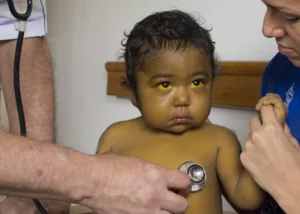Non-alcoholic hepatic steatosis, or non-alcoholic fatty liver disease, is one of the diseases that frequently appears in overweight people. Here we will know the risks of suffering from the disease and how to avoid it.
In the previous article we talked about how one of the most common liver complications is non-alcoholic fatty liver disease. This disease is caused when a person gains weight and accumulates an abundance of fat in the body. If the percentage of fat increases and is maintained for a long time, inflammation of the liver occurs.
At the same time, we mentioned that there are two types of non-alcoholic fatty liver disease, which are simple fatty liver and non-alcoholic hepatic steatosis, both have the characteristic of inflammation in the liver but one presents symptoms and the other does not.
We invite you to see what causes non-alcoholic fatty liver disease and non-alcoholic steatohepatitis and what are the signs or symptoms that should be taken into account for this disease. This time, we will talk about how this liver condition is diagnosed, the risks and how to treat it.
How is non-alcoholic fatty liver disease diagnosed?
Usually, the diagnosis is first suspected in those who are overweight with slightly elevated results in liver tests performed during any regular blood test.
Some experts now recommend that every obese child or adolescent should have their liver enzymes checked, as non-alcoholic fatty liver disease may be present even if blood test results are normal.
It is not easy to identify nonalcoholic fatty liver disease because the symptoms are often not really noticeable. A medical specialist may suspect steatohepatitis if you get abnormal results on liver tests that you have had for other reasons. To make a diagnosis, your doctor will use:
- Your medical history.
- A physical examination.
- Various tests, including blood tests and imaging, and sometimes a biopsy.
What are the risks of nonalcoholic steatohepatitis disease?
Although people with nonalcoholic fatty liver disease usually have no problems from the condition, about 25% of those with the disease may develop liver fibrosis that worsens over time. Generally the progression of fibrosis is slow and can take years or even decades.
For some patients, the fibrosis may stabilize and there are cases in which people lose a considerable amount of weight and then the fibrosis is found to have reversed.
In others, however, the condition continues to progress and fibrous tissue accumulates in the liver, leading to cirrhosis. In the United States, it is increasingly common that the reason for performing a liver transplant is for non-alcoholic steatohepatitis.
What are the treatments for fatty liver?
For non-alcoholic fatty liver disease, doctors recommend losing weight. This helps reduce fat, inflammation and fibrosis in the liver. If a doctor believes that a medication is the cause of fatty liver, it is necessary to stop taking the medication. In turn, you may need to gradually lower the dose of that medicine, or you may need to take another medicine instead.
There are no drugs that have been approved to treat fatty liver. Studies are looking at whether a certain diabetes drug or vitamin E may help, but more research is needed.
It is important to control energy intake because energy that is not used on a day-to-day basis will be transformed into new fat, which also accumulates in the liver. So having a balanced diet and exercising are good options.














